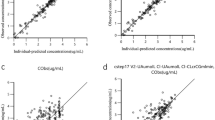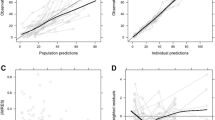Abstract
Objective
To evaluate and compare the pharmacokinetic profiles of imipenem and meropenem in a population of critically ill patients with sepsis to find possible differences that may help in selecting the most appropriate drug and/or dosage in order to optimise empiric antimicrobial therapy.
Patients and methods
This was a single-centre, randomised, nonblind study of the pharmacokinetics of both intravenous imipenem 1g and meropenem 1g in 20 patients admitted to an intensive care unit with sepsis in whom antimicrobial therapy was indicated on clinical grounds. Patients were divided into two groups: group I received intravenous imipenem 1g plus cilastatin 1g, and group II received intravenous meropenem 1g over 30 minutes. Peripheral blood samples were collected at 0, 0.5 (end of infusion), 0.75, 1, 1.5, 2, 3, 4, 6 and 8 hours after the first dose and were centrifuged for 10 minutes at 4°C. Urine samples were collected during the 8 hours after antimicrobial administration at 2-hour intervals: 0–2, 2–4, 4–6 and 6–8 hours. The total volume of urine was recorded; the serum and urine samples were immediately frozen and stored at −80°C until assayed. Pharmacokinetic analysis was carried out through computerised programs using the least-square regression method and a two-compartment open model. Statistical differences were evaluated by means of one-way ANOVA.
Results
The following pharmacokinetic differences between the two drugs were observed: the imipenem mean peak serum concentration was significantly higher than for meropenem (90.1 ± 50.9 vs 46.6 ± 14.6 mg/L, p < 0.01); the area under the serum concentration-time curve was significantly higher for imipenem than for meropenem (216.5 ± 86.3 vs 99.5 ± 23.9 mg · h/L, p < 0.01), while the mean volume of distribution and mean total clearance were significantly higher for meropenem than for imipenem (25 ± 4.1 vs 17.4 ± 4.5L, p < 0.01 and 191 ± 52.2 vs 116.4 ± 42.3 mL/min, p < 0.01, respectively).
Conclusion
The more favourable pharmacokinetic profile of imipenem compared with meropenem in critically ill patients with sepsis might balance the possibly greater potency demonstrated in vitro for meropenem against Gram-negative strains. Hence, the clinical efficacy of the two carbapenems depends mostly on their correct dosage.







Similar content being viewed by others
References
Balfour JA, Bryson HM, Brogden RN. Imipenem/cilastatin: an update of its antibacterial activity, pharmacokinetics and therapeutic efficacy in the treatment of serious infections. Drugs 1996; 51(1): 99–136
Rhomberg PR, Jones RN. Antimicrobial spectrum of activity for meropenem and nine broad spectrum antimicrobials: report from the MYSTIC Program (2002) in North America. Diagn Microbiol Infect Dis 2003; 47(1): 365–72
Norrby SR, Newell PA, Faulkner KL, et al. Safety profile of meropenem: international clinical experience based on the first 3125 patients treated with meropenem. J Antimicrob Chemother 1995; 36 Suppl. A: 207–23
Wiseman LR, Wagstaff AJ, Brogden RN, et al. Meropenem: a review of its antibacterial activity, pharmacokinetic properties and clinical efficacy. Drugs 1995; 50(1): 73–101
Bax RP, Bastain W, Featherstone A, et al. The pharmacokinetics of meropenem in volunteers. J Antimicrob Chemother 1989; 24 Suppl. A: 311–20
Mouton JW, Touzw DJ, Horrevorts AM, et al. Comparative pharmacokinetics of the carbapenems: clinical implications. Clin Pharmacokinet 2000; 39(3): 185–201
Pfaller MA, Jones RN. A review of the in vitro activity of meropenem and comparative antimicrobial agents tested against 30,254 aerobic and anaerobic pathogens isolated world wide. Diagn Microbiol Infect Dis 1997; 28(4): 157–63
Pfaller MA, Jones RN, Biedenbach DJ, et al. Antimicrobials resistance trends in medical centers using carbapenems: report of 1999 and 2000 results of the MYSTIC program (USA). Diagn Microbiol Infect Dis 2001; 41: 177–82
White RL, Friedrich LV, Manduru M, et al. Comparative in vitro pharmacodynamics of imipenem and meropenem against ATCC strains of Escherichia coli, Staphylococcus aureus and Bacteroides fragilis. Diagn Microbiol Infect Dis 2001; 39(1): 39–47
Nilsson-Ehle I, Hutchison M, Haworth SJ, et al. Pharmacokinetics of meropenem compared to imipenem-cilastatin in young, healthy males. Eur J Clin Microbiol Infect Dis 1991; 10(2): 85–8
Saito A. Pharmacokinetic study on meropenem. Chemotherapy 1992; 40 Suppl. 1: 276–82
Dreetz M, Hamacher J, Eller J, et al. Serum bactericidal activities and comparative pharmacokinetics of meropenem and imipenem-cilastatin. Antimicrob Agents Chemother 1996; 40(1): 105–9
Bush LM, Levison ME. Antibiotic selection and pharmacokinetics in the critically ill. Crit Care Clin 1988; 4(2): 299–324
Neugebauer E, Dietrich A, Lechleuthner A, et al. Pharmacotherapy in shock syndromes: the neglected field of pharmacokinetics and pharmacodynamics. Circ Shock 1992; 36(4): 312–320
Bone RC, Balk RA, Cerra FB, et al. Definitions for sepsis and organ failure and guidelines for the use of innovative therapies in sepsis: the ACCP/SCCM Consensus Conference Committee. American College of Chest Physicians/Society of Critical Care Medicine. Chest 1992; 101(6): 1644–55
Le Gall JR, Lemeshow S, Saulnier F. A new simplified acute physiology score (SAPS II) based on a European/North American multicenter study. JAMA 1993; 270(24): 2957–63
Vincent JL, Moreno R, Takala J, et al. The SOFA (Sepsisrelated Organ Failure Assessment) score to describe organ dysfunction/failure: on behalf of the Working Group on Sepsis-Related Problems of the European Society of Intensive Care Medicine. Intensive Care Med 1996; 22(7): 707–10
Pea F, Furlanut M. Pharmacokinetic aspects of treating infections in the intensive care unit: focus on drug interactions. Clin Pharmacokinet 2001; 40(11): 833–68
Cockcroft DW, Gault MH. Prediction of creatinine clearance from serum creatinine. Nephron 1976; 16(1): 31–41
Mazzei T, Tonelli F, Novelli A, et al. Penetration of cefotetan into suction skin blister fluid and tissue homogenates in patients undergoing abdominal surgery. Antimicrob Agents Chemother 1994; 38(9): 2221–3
Novelli A, Mazzei T, Meli E, et al. Clinical pharmacokinetics of meropenem after the first and tenth intramuscular administration. J Antimicrob Chemother 1996; 37(4): 775–81
Gibaldi M, Perrier D. Pharmacokinetics. New York (NY): Marcel Dekker, 1982
Mouton JW, Vinks AA. Is continuous infusion of β-lactam antibiotics worthwhile: efficacy and pharmacokinetic considerations. J Antimicrob Chemother 1996; 38(1): 5–15
Kitzes-Cohen R, Farm D, Piva G, et al. Pharmacokinetics and pharmacodynamics of meropenem in critically ill patients. Int J Antimicrob Agents 2002; 19(2): 105–10
Diekema DJ, Pfaller MA, Jones RN, et al. Survey of blood-stream infections due to Gram-negative bacilli: frequency of occurrence and antimicrobial susceptibility of isolates collected in the United States, Canada, and Latin America for the SENTRY Antimicrobial Surveillance Program, 1997. Clin Infect Dis 1999; 29(3): 595–607
Fluit AC, Jones ME, Schmitz FJ, et al. Antimicrobial resistance among urinary tract infection (UTI) isolates in Europe: results from the SENTRY Antimicrobial Surveillance Program 1997. Antonie Van Leeuwenhoek 2000; 77(2): 147–52
Thalhammer F, Traunmuller F, el Menyawi I, et al. Continuous infusion versus intermittent administration of meropenem in critically ill patients. J Antimicrob Chemother 1999; 43(4): 523–7
Burgess DS. Pharmacodynamic principles of antimicrobial therapy in the prevention of resistance. Chest 1999; 115 (3 Suppl.): 19–23S
Craig WA, Ebert SC. Continuous infusion of β-lactam antibiotics. Antimicrob Agents Chemother 1992; 36(12): 2577–83
Hyatt JM, McKinnon PS, Zimmer GS, et al. The importance of pharmacokinetic/pharmacodynamic surrogate markers to out-come: focus on antibacterial agents. Clin Pharmacokinet 1995: 28(2): 143–60
Schentag JJ, Gilliland KK, Paladino JA. What have we learned from pharmacokinetic and pharmacodynamic theories? Clin Infect Dis 2001; 32 Suppl. 1: S39–46
Thomas JK, Forrest A, Bhavnani SM, et al. Pharmacodynamic evaluation of factors associated with the development of bacterial resistance in acutely ill patients during therapy. Antimicrob Agents Chemother 1998; 42(3): 521–7
Nordmann P, Poirel L. Emerging carbapenemases in Gramnegative aerobes. Clin Microbiol Infect 2002; 8(6): 321–31
Tegeder I, Schmidtko A, Brautigam L, et al. Tissue distribution of imipenem in critically ill patients. Clin Pharmacol Ther 2002; 71(5): 325–33
Lam YW, Banerji S, Hatfield C, et al. Principles of drug administration in renal insufficiency. Clin Pharmacokinet 1997; 32(1): 30–57
Giles LJ, Jennings AC, Thomson AH, et al. Pharmacokinetics of meropenem in intensive care unit patients receiving continuous veno-venous hemofiltration or hemodiafiltration. Crit Care Med 2000; 28(3): 632–7
Acknowledgements
This work was partially supported by the Italian Ministry of Education, University and Research (MIUR) with the national research fund no. 2003051858_004
Author information
Authors and Affiliations
Corresponding author
Rights and permissions
About this article
Cite this article
Novelli, A., Adembri, C., Livi, P. et al. Pharmacokinetic Evaluation of Meropenem and Imipenem in Critically Ill Patients with Sepsis. Clin Pharmacokinet 44, 539–549 (2005). https://doi.org/10.2165/00003088-200544050-00007
Published:
Issue Date:
DOI: https://doi.org/10.2165/00003088-200544050-00007




